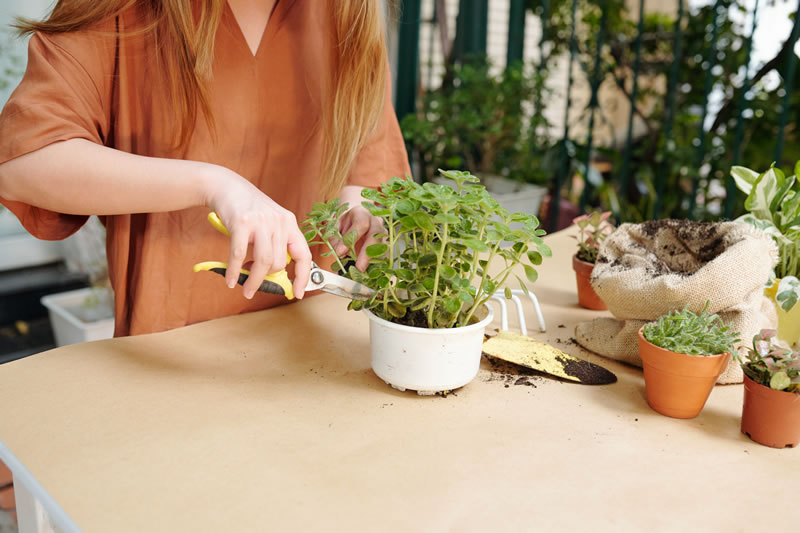You might want to begin growing mint indoors if you live in a climate where it’s too cold to grow it in the ground.
Mint is easy to grow and has a range of health benefits, as well as having a great taste.
But can you grow mint indoors?
It is possible to grow mint outdoors. Mint is a very strong growing herb capable of thriving in sunlight or shade conditions. Mint requires 1 inch to 2 inches of water per week indoors, and best to keep the soil moist. A windowsill is a perfect place to grow mint indoors.
You don’t need to be a gardening expert or a gardener at all to see your mint turn out like it should.
There are different types of mint, some of which are better than others for growing indoors. Spearmint and peppermint are the best options for indoor mint growing, since they are so hardy and require little effort.
How to Grow Mint Indoors – The Beginners Guide
Mint truly is one of the best things for beginners to indoor gardening to start to grow.
In fact, growing mint is one of the ways many indoor gardeners stumbled on to their hobby. After watching the success of their mint and using it in tea and food dishes, it generally leads on to other herbs, plants and then on to vegetables and fruit.
It can be really exciting watching everything grow!
Here is a beginner’s step by step guide to growing mint indoors:
Step 1 – Choose the right container
There isn’t a ‘right’ container for mint, but there is a right container for the space you have at home. A rectangle container is great for windowsill growing, which can be better for growth so your mint can bask in the sun’s rays for longer.
A round container will of course work just as well, as long as it fits neatly in which ever location you decide to grow.
Step 2 – Decide on the type of mint you want to grow
There are two main types of mint to grow at home, these are:
- Peppermint
- Spearmint
Which mint you decide to grow is up to you. There are no distinct advantages of choosing one mint over the other. Both are easy to grow, require similar levels of sunlight and water and both have the health and aroma qualities.
If you have two separate pots, you could decide to grow them both!
Step 3 – Add Soil to the Container
Its time to get those green finger hands dirty again and add some soil to the container.
Regular potting soil, which already is rich in nutrients, works really well for mint.
Fill to container to around 50% to 75% from the top and plant your mint!
Step 4 – Add Water
Mint like water. They can survive with reduced sunlight, but they will struggle without the correct amount of watering.
Many indoor gardeners overwater their plants.
It’s a natural mindset and generally this is done to compensate for there being no rain indoors of course, as well as a more humid atmosphere.
Although mint loves water, you need to be careful not to over water as it grows.
Tip: If you can feel the soil is moist, by placing your finger in, then doesn’t need water
You should aim to give your mint around 1 inch to 2 inches of water per week on average.
Step 5 – Trim as it grows
To keep your mint from growing too wildly you should trim the leaves as it grows.
Not only does it keep your mint under control, but by trimming the leaves it encourages growth and strengthens it, too.
Step 6 – Organic Fertilizer
To aid your mints growth, and help it along its way, you can add a little organic fertilizer to the soil.
Use a fertilizer mix or a dissolvable pellet – both are available online or from your local gardening shop – and your mint should bloom stronger and fuller.
The Benefits of Growing Mint

Mint is one of those plants that love company, and it thrives in the company of other plants.
Whether indoors or outdoors, it provides a great environment for other plants because it’s a non-aggressive species, too.
Many plants are versatile in this way and adapt well to their surroundings.
This is just one of the many benefits mint has provided those who have cultivated it for many, many years.
This is why indoor gardening has becoming the successful hobby it has become.
Some other benefits include:
Growing mint does not require a lot of space
It’s such a small plant, mint simply doesn’t require much space or maintenance, making it ideal for container gardening.
This is something many indoor gardeners specifically look for.
Very easy-to-grow herb
Mint is very easy to grow. In fact, it’s such a simple plant and requires little care, attention or maintenance. It’s a regular self-sufficient plant.
It’s a perfect houseplant
Like a welcome house guests, mint is a perfect houseplant. It likes to show consideration to other plants and flowers, and in turn they seem to want to reciprocate.
The last thing you want is an invasive plant bully!
Have a strong and refreshing scent that will help you relax
Mint is known for many qualities but especially it’s quality to relax.
Perhaps the fresh clean scent helps clear the nostrils, as well as mind, but time and time again studies show that mint works remarkably well for relaxation.
A unique taste, and used to flavor a variety of dishes
If you search for ‘Mint Recipes’ in Google, it’ll show you 313,000,000 results.
Yes, that is 313 million results for recipes that include mint!
Suffice to say that growing mint gives you an amazing herb to spontaneously add to many dishes, especially when unexpected guests come round to call.
Doesn’t just add decoration, but also has health benefits too
It is a natural remedy for several health issues like stomach upsets and other stomach and bowel related problems, mint also it has antimicrobial properties too.
Mint leaves can help you to treat indigestion and bloating
Have you ever wondered why many restaurants hand out mints after you have finished your meal?
Mint has long been known to be a fast-acting solution to indigestion and bloating, which of course is common after eating a large meal.
Mint tea is also used to settle the stomach.
Frequently Asked Questions
Can mint grow in low light?
Mint thrives in both sunny and low-light conditions. Even if placed in a shady corner or where it will receive partial sunlight, mint will grow just fine.
Can mint grow indoors without sunlight?
Although mint prefers natural sunlight it can be grown indoors without sunlight directly shining on it. When grown indoors, a grow light is recommended to provide it with the 4 hours of real or artificial sunlight recommended to produce healthy, fresh mint leaves.
Do you water mint daily?
Yes, mint should be watered every day. Although mint can grow without much sunlight, it needs moist soil to thrive. In total, between 1 and 2 inches of water per week is recommended.
If you are using water-retaining soil, adjust your watering schedule by the manufacturer’s recommendation.
How can you encourage mint to grow indoors?
The best way of encouraging mint to grow indoors is to place the container in direct sunlight, or help its growth using an indoor grow lamp. Of course, keep up the recommended watering schedule and use a soil rich in nutrients as you would with any other plant, flower, succulent or vegetable.
In Conclusion – Growing Mint Indoors
Mint is a wonderful herb to grow indoors.
It not only adds many well-known and documented health benefits, as well as culinary enhancements, but mint also provides a sweet aroma within your home.
Its low level sunlight requirements make it a perfect addition to your indoor garden, especially in areas lacking natural daylight.
Watering is important and you’ll need to keep the soil moist. 1 inch to 2 inches of water per week are recommended, as well as soil rich in nutrients.
